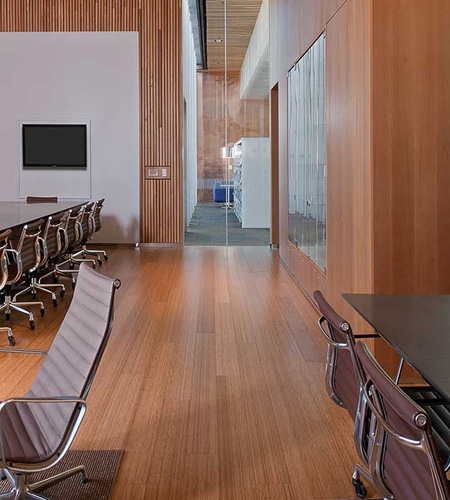
Parquet strip - Floor installation advice
General: Plexwood is composed of end grain wood and wood with the grain, the processing differs from other tongue and groove flooring
Acclimatization: Allow Plexwood to acclimatize under the conditions in which it will be used
Products: Plexwood is a combined product composed of end grain wood and wood with the grain, therefore not all glues, fillers and finishers that are regularly used for wood are also suitable for this type of wood structure, run a test if necessary, and always follow the processing advice
Sub-floor: Inspect the sub-floor following the checklist below, delay work if necessary
Intermediate floor: If necessary an intermediate floor can be laid, use at least a high density particle board, and always ensure a proper attachment to the sub-floor
Expansion joint: An expansion joint is necessary
Post-treatment: After laying, level and roughen the floor
Laying pattern: Determine the pattern to be laid, take into account the incidence of light
Processing: Mix about ten packs each time, to begin, cut a number of Parquet strips in random lengths, and start a band in flying bond, set out a chalk line and alongside this line and apply appropriate glue, in which the Parquet strips are laid
Fixation: Apply appropriate glue, fix the Parquet strip by nailing blind rivets, or use weights, and always make sure that the Parquet strips join well both widthways and in longitudinal direction, for this make use of small blocks, work preferably as much as possible against the tongue-side, check regularly whether the strips bond sufficiently (80%) in the glue-bed
Sanding: Sand with a rotating three-headed disc sanding machine (belt sanding or sanding with an orbital disc is generally not suitable for Plexwood), sand the edges with an edge sander and the corners with a delta sanding machine, all with 80-grit, in the first sanding pass, sand away all unevenness, glue remainders and/or spots, always sand in long overlapping passes in the length of the Plexwood
Filling: Fill holes and cracks with a homogeneous mixture of filler and wood dust (80-grit), press the mixture well into holes and cracks with a stainless steel taping knife, after the drying period fill the entire floor a second time, polish the floor afterwards with 80-grit
Oil/wax: Make the floor dirt and dust free, apply the oil in the length of the Plexwood using a stainless steel taping knife, work in straight bands with a sharp edge, rub each edge immediately with a white pad, if necessary oil and rub the floor again, after the drying period the wax is applied in narrow bands, which are rubbed in wider until the floor has an even gloss, allow rubbing pads to dry in ventilated area
Varnish: Make the floor and expansion joints dirt and dust free, apply a thick layer with a mohair roller, work in wet-on-wet overlapping bands of 1.5 meters wide, in the length direction of the Plexwood, divide in the width and roll out overlapping in the length, keep a sharp edge on the band, use a brush along the walls, after drying period do intermediate sanding with 80-grit and spread a thin varnish layer, when this is dry finish varnish off with a roller and brush
Checklist inspection sub-floor according to DIN 18365, sub-floor check for parquet floors
Levelness: Measured according to NEN 2741 with a levelling beam of 2 meter, the maximum deviation allowed is 0.4 % of the levelling beam
Cracks: Assess visually
Moisture content: Measured according to the carbide method
In sand cement covering floor/concrete floor ≤ 2.0 % (regular) ≤ 1.8 % (with floor heating)
With anhydrite flooring ≤ 0.5 % (regular), ≤ 0.3 % (with floor heating)
Firmness: Assess using an RIRI apparatus or steel wire brush
Roughness: Assess visually
Expansion: Assess visually
Pollution: The floor must be clean, dust and oil free, assess visually
Vertical deviation: Measure in comparison with adjacent building components
Temperature sub-floor: Must be between 15 - 28 ºC, measure using electronic infrared temperature sensor (for example Gann IR-40)
Temperature environment: Must be ≥ 15 ºC, ideally between 18 - 20 ºC, measure using electronic infrared temperature sensor (for example Gann RF-T)
Relative atmospheric humidity: Must be between 50 - 65 %, measure using electronic hygrometer (for example Gann RF-T)
Floor heating: surface temperature of the sub-floor can be 28 ºC at most (supplementary heating), ask for the heating protocol, preferably installed according to the spiral casing principle
Pipework: The heating pipes must be a minimum of 30 mm below the top of the sub-floor
























